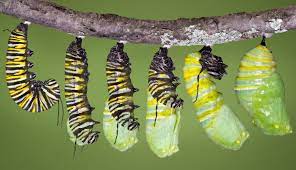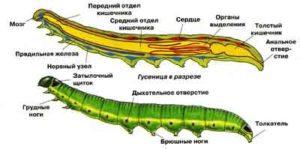Butterfly larva - such different caterpillars
Beautiful fluttering butterflies are not born like that, but become. At first they live several lives, in different shapes and forms. One of them is a caterpillar, a larva of Lepidoptera butterflies, a moth.
Content
Various caterpillars (photo)
Description of caterpillars
A caterpillar is a stage in the development of an insect that develops from an egg to a chrysalis, from which the butterfly itself subsequently appears.
A caterpillar in this stage can live for several days, weeks or even months, it all depends on the species.
Size, shade, and even feeding habits are characteristics that vary by species. But the structure is the same - only the presence or absence of a process in the form of a horn or several can differ.
| Torso | There are individual tiny species, but there are also huge ones. The body consists of the head, thoracic, abdominal, and limbs. |
| Head | It consists of 6 segments that have grown together and formed a capsule. There is a forehead, cheeks, occipital foramen. Some have antennae or horns. |
| Mouth | Caterpillars eat all their lives. They have a well-developed mouth apparatus, at the top there are cloves for biting off, inside for chewing. |
| Eyes | Primitive consisting of one lens. Most often there are 5-6 pairs of eyes, which are located one after the other. |
| Corpuscle | Consists of several segments, which are separated by grooves. It is soft and very flexible. Ends with an anus. |
| respiratory organ | The spiracle of the stigma is located on the chest. Those individuals that live in the water have tracheal gills. |
| Limbs | Almost all have 3 pairs of limbs on the chest and 5 pairs of false legs on the abdominal region, which have a sole and a claw. |
| Cover | Even those caterpillars that look monotonous, covered with hairs, do not exist naked. But the presence of processes or bristles depends on the species. |
Life cycle and all stages of transformation - a real miracle.
Moulting caterpillar
At the stage of development and preparation for pupation, the caterpillar eats a lot, so it needs to change its skin. This process is called molting and occurs more than once. Depending on the species and gender, the number can be from 2 to 40 times, but most often 5-7.
Lifestyle and habitat
Caterpillars most often live on land, but there are several specimens underwater. Some species are adapted for both options. Conventionally, caterpillars are divided into 2 types according to the type of existence: secretive and free.
The lifestyle also depends on this: there are those that actively move, but also individuals that prefer not to move far from food sources. They, due to their short life, are most often unpretentious to living conditions.
Caterpillar nutrition
Almost all caterpillars feed on plants. Only a few individuals are predators that eat insects (aphids) and attack weakened representatives of their kind. There are 4 main types:
Some types of caterpillars
Insects can vary in size and features. They are either very large or small.
For the most part, these animals prefer not to contact people. But there are a number dangerous specieswhich are very poisonous.
For more detailed information, please continue with species of caterpillars here.
Caterpillars to fight
Many of the insects are agricultural pests. They eat cultivated plantings - fruits, vegetables, shrubs and trees. If you have to deal with them, then you need to use some of these methods.
This is the collection, shaking or cutting of caterpillars or masonry. This also includes trap belts on a glue basis or traps with liquids for baits.
These are natural enemies that caterpillars eat. They can be attracted to the site. These include birds and some insects.
The use of poisonous drugs that are effective, but have a number of contraindications and difficulties.
The use of infusions and decoctions are used in cases where the infection is not very large.
The transformation of larvae into butterflies

Caterpillar metamorphoses.
By definition, caterpillars are larvae that turn into a butterfly, absolutely everything. Some species are one- or two-day butterflies that live only to lay eggs.
But voracious animals do not always complete their life cycle. They may be eaten or fall prey to parasites.
There are insects that look like caterpillars, but they are not. They are called false caterpillars. These are the larvae of some beetles, worms, wasps or ants.
Conclusion
The caterpillar is an interesting insect. It is like a passing link that allows another creature to be born. They can be large or tiny, bright or inconspicuous, harmless or dangerous.

